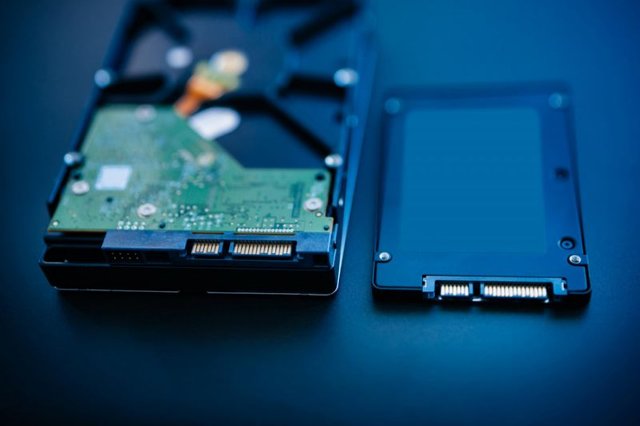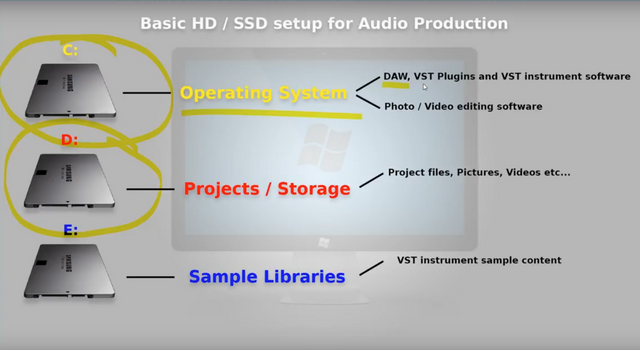Tutorial DAW # 2 - Basic Setup Hard Drives for Audio Production ( Digital Audio Workstation )
Today we're going to be looking at something a little bit different we'll be talking about basic hard drive setup for your audio production workstation so if you if you want to learn about raid array setups how to set up backup mirrors or even more advanced things like vienna ensemble pro master slave setup then i'd suggest looking elsewhere on youtube for these because as loads of videos already out there which people have done which provide you enough information on those topics we're just going to be looking at the basic principles behind how you should be installed in your software way should be installing it to where you should be saving your files and projects to and how you should be setting up your sample libraries for audio production things that you tend to install to your operating system driver your C Drive is generally speaking all of your programs so anything like a da w e music software such as Cubase Pro Tools Logic Presonus Studio One whatever you use in that will be installed to your C Drive seems like VST plugins' eq's compresses effects all that C Drive and then when it comes to VST instruments the software side of things the program the VST instruments program will also get installed to the C Drive the reason why we don't do things like save our files to receive drive our pictures and videos or samples from our VST instruments to C Drive is there's a couple of important reasons the first major reason is that if anything ever goes wrong with your main OS Drive and it crashes and dies a horrible death or you need to clean format because you've somehow got a virus then you're going to lose all of this information and you're going to have to reinstall all your software and your sample content but the other thing is that you're going to lose all your project files your pictures in the videos and stuff so it's never a good idea to install everything to one drive.
Another reason being is that with hard drives you have they have this thing called read and write so depending on the performance of your hard drive if it's an SSD or if it's a mechanical hard drive there is a to how much data it can access at any given moment if you have too many things on one hard drive and it's trying to access all this different information here in one go you get this thing called a bottleneck now think of it as a tunnel and this is the big blob of everything trying to fit through that tunnel it's going to hit the sizing is just going to drip through a bit by a bit so the performance of your hard drive is going to be dead slow so if you have it all methodical with things and you install them separately across different hard drives when it comes to this tunnel this stuff is just going to work it's going to get loaded into Ram and it's just going to work nice and easy no no qualms no traffic no no it's just to be nice and quick so with your operating system you see drive it's just mainly all the software side of things that you're going to be installing or anything like your personal files your videos your pictures your projects and all that that's going to get installed to a separate drive which most of you will have if you've bought an entry-level PC they tend to be mechanical hard drives for this you can use SSDs if you want SSDs are always quicker much more efficient but for you know storage mechanical hard drives are fine the good thing about is that they're cheap so you'll probably have something like a one terabyte heart keep it up at t6 it not only have like a one terabyte two terabyte something mother it's always a good idea to have very

large storage drives if you know you're going to be storing a lot of things on there so with mechanical hard drives are a lot cheaper than SSD so you get more storage capacity for the price so it's pretty self-explanatory really anything that's not software related so audio files for your projects or pictures or videos anything you can store them to install them save them to a projects drive now if you're a little bit more kind of anal about it for lack of a better word you can have a separate drive so I have a separate Drive and I have another mechanical hard drive which I store all my project files on and then the rest of Italy pictures and videos in that I store on a separate drive so I have two drives for storage and just because of how I work I do a bit of video editing software my setup a little bit different now when it comes to sample libraries to a different story altogether with sample libraries I always recommend getting an SSD Drive just because the sheer amount of samples which have been shifted across the hard drive when you're screaming them from the disk in your da W is ridiculous it's mind-boggling like one note of an instrument could be like a thousand samples so when you think about having lots of instruments loaded up in a session and you playing all these different samples especially high-end sample libraries and you're going to need a very quick hard drive which it's got a decent sized capacity to handle all these things on or you can get multiple smaller versions of hard drives and break them down that way across the hard drive so when you're installing a VST instrument like an orchestral library or an O guitar library something matter you'll find that there's three different stages to install it on the first one is the software so it will ask you about installed software you'll tell it your C Drive wherever you want in your C Drive the second thing it'll ask you is where it would like to install with DDL files or dll files that's one or two which is the sort of like the same file as a VST plug-in uses so when you've got your da W open it'll ask you where this file is so it knows where to load the instrument from so it's always a good idea to also install that to your C Drive as well and then the final thing is the sample content which is the large portion of the software this is what you want to be installing onto a separate drive completely so I have a dedicated hard drive just for sample library content now there's a good reason why obviously does do good reasons a it reduces a bottleneck and B if if you do meter you know this dies and you need to reinstall everything then you're not going to be spending days and days installing sample content to your hard drive because you're got it on a separate drive and the beauty of this is when I come to reinstall things if anything went fatally wrong which it hasn't done yet touchwood for many years and then all you need to do is install the software which takes seconds and then you just point the software to where you've got the the sample content installed and it'll just work so that's that's another bonus to splitting things across your hard drives so in terms of the basics it's always a good idea to have at least three hard drives in your computer and as this will improve the performance reduce the bottlenecks and you know things will be running a lot more smoothly for when you're creating your chains so that's pretty much it for this video guys it's just a very brief basic overview of how you should be installing things and where they should be installed to and now you should be saving your projects.
